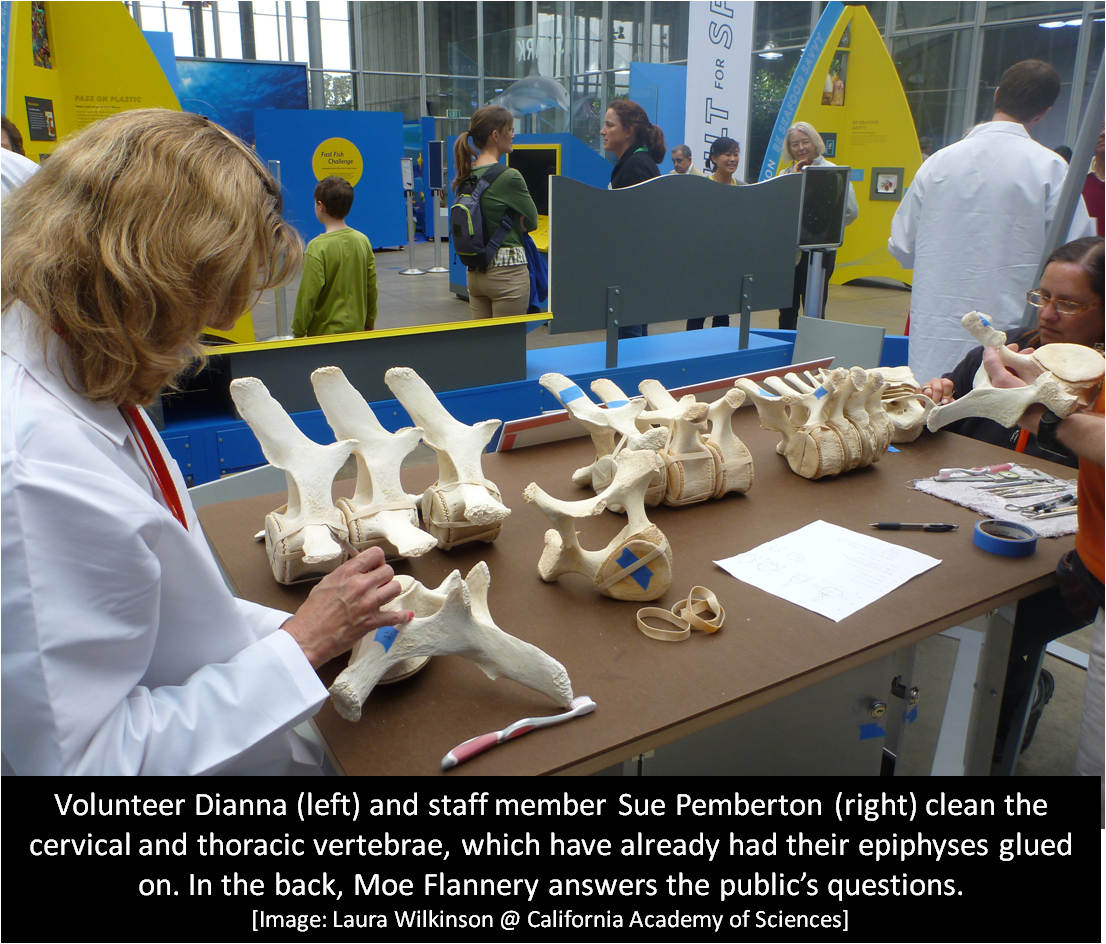
Now that I’ve told O319’s story, it’s time to get to the fun part – the articulation!  We started on Wednesday, May 8th by sorting through the vertebrae and grouping them by type from head to tail: cervical, thoracic, lumbar, and caudal. Once sorted, they were then ordered based on size measurements taken of each vertebrae. Since O319 was still a young animal (by orca standards), the vertebral epiphyses had not yet fused to the vertebrae. This means that each vertebra had two separated plates (which Lee Post refers to as “cookies”) that needed to be matched up. We had a fun task of sorting through the epiphyses and matching each up to the correct end of each vertebra. Each epiphysis can only fit correctly in one orientation on one specific side of a vertebra, so once you get a match it “clicks” into place. We then glued the epiphyses on to the vertebrae, secured them with rubber bands, and let them dry overnight. Next, we did some fine-tuning of each bone, cleaning off any remaining sand and small bits of dried-on grease.
We started on Wednesday, May 8th by sorting through the vertebrae and grouping them by type from head to tail: cervical, thoracic, lumbar, and caudal. Once sorted, they were then ordered based on size measurements taken of each vertebrae. Since O319 was still a young animal (by orca standards), the vertebral epiphyses had not yet fused to the vertebrae. This means that each vertebra had two separated plates (which Lee Post refers to as “cookies”) that needed to be matched up. We had a fun task of sorting through the epiphyses and matching each up to the correct end of each vertebra. Each epiphysis can only fit correctly in one orientation on one specific side of a vertebra, so once you get a match it “clicks” into place. We then glued the epiphyses on to the vertebrae, secured them with rubber bands, and let them dry overnight. Next, we did some fine-tuning of each bone, cleaning off any remaining sand and small bits of dried-on grease.


After all the vertebrae were successfully numbered, matched with their epiphyses, and cleaned, we pulled all of the rib bones out with  the goal of matching each pair together, distinguishing which ribs went on the left and right sides of the Orca, and putting them in order from head to tail. It was surprisingly easier than it sounded. Potential pairs of ribs were pushed together with the curved ends facing each other. If the ends "kissed," it meant that the ribs were both the same size and should therefore be a matched pair.
the goal of matching each pair together, distinguishing which ribs went on the left and right sides of the Orca, and putting them in order from head to tail. It was surprisingly easier than it sounded. Potential pairs of ribs were pushed together with the curved ends facing each other. If the ends "kissed," it meant that the ribs were both the same size and should therefore be a matched pair.
It’s been really fun working on this project on the main floor. Having a chance to chat with the public and explain a process that they’ve  likely never seen before, as well as teach them about Orcas, has been a wonderful experience for not only our staff and volunteers, but also our visitors. We all cycle through shifts of working on the bones and talking with the public, so everyone that you chat with should have a lot of information about the articulation process.
likely never seen before, as well as teach them about Orcas, has been a wonderful experience for not only our staff and volunteers, but also our visitors. We all cycle through shifts of working on the bones and talking with the public, so everyone that you chat with should have a lot of information about the articulation process.
Come by the Orca Lab Tuesdays through Sundays, chat with our staff and volunteers, and see what we’re up to next! If you have any questions about the project, leave a comment here and we'll be sure to respond.
-Laura Wilkinson, Curatorial Assistant and Specimen Preparator, Ornithology and Mammalogy
All marine mammal stranding activities were conducted under authorization by the National Marine Fisheries Service through a Stranding Agreement issued to the California Academy of Sciences and MMPA/ESA Permit No. 932-1905/MA-009526.